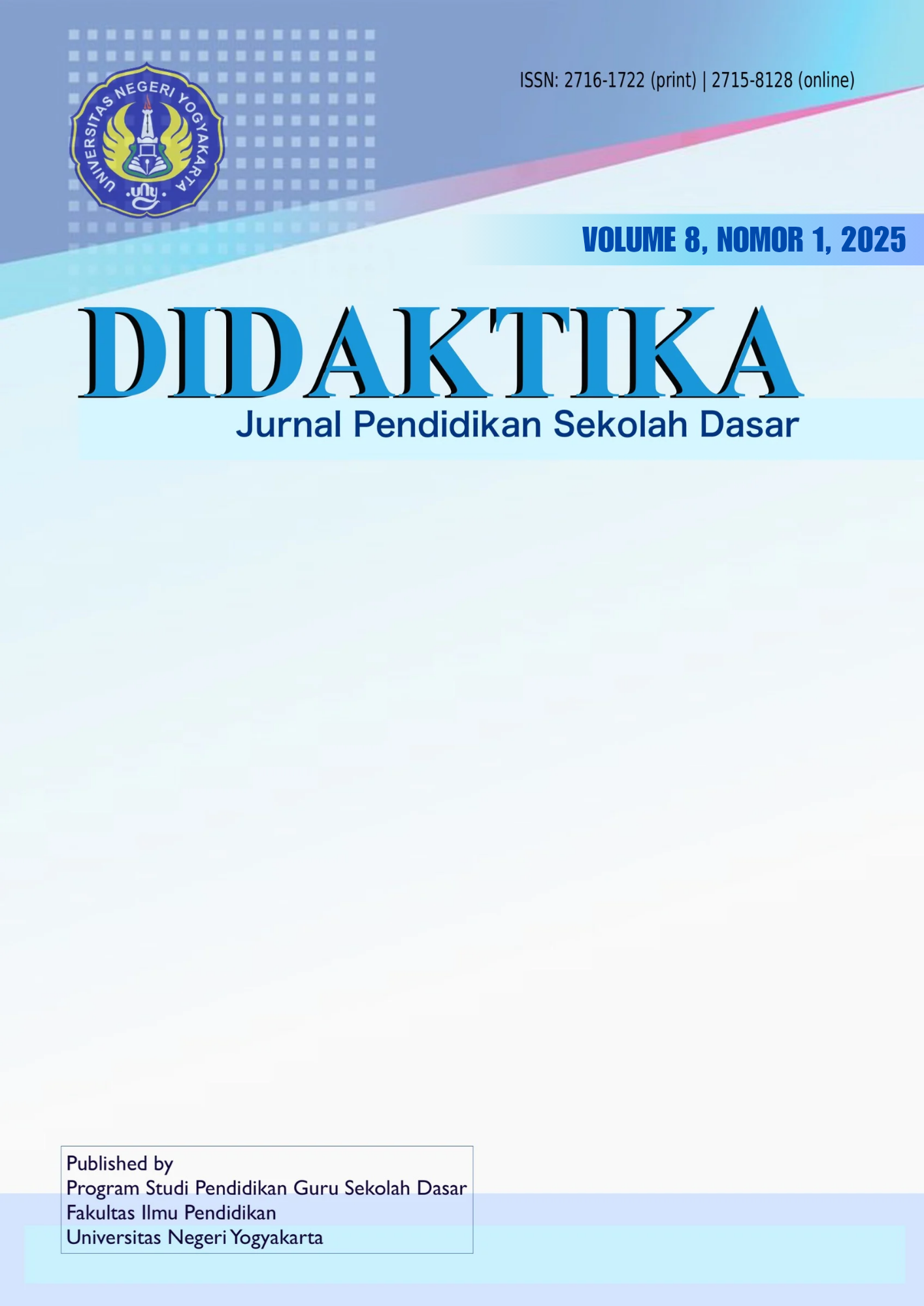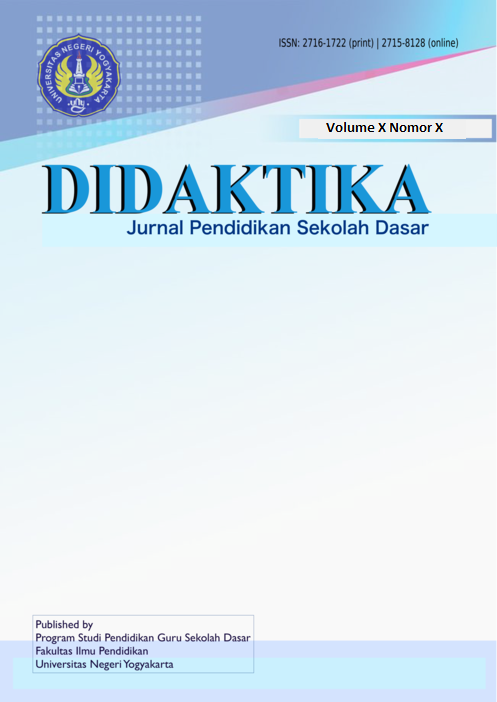Development of Mystery Box Media "Taringbarua (Pull the Net of Building Space)" In Learning Mathematics for Elementary School Students
Abstract
This study addresses the issue of inadequate use of learning tools among students, which leads to decreased interest, reduced focus, and limited understanding of the material. It is the goal of this study to create a media mystery box taringbarua (pull the net wake space) that is trustworthy, useful, and aware of how it might affect the mathematics learning of elementary school children. ADDIE (Analysis, Design, Development, Implementation, and Evaluation) development model is used in this type of work as part of the research and development (R&D) method. There were 44 fifth graders from SD Negeri in the south Bangka area who took part in the study. To get information, we used tests, surveys, and interviews. E The N-Gain score was used for quantitative analysis, while qualitative data were analyzed through thematic review. Findings from the validity acquisition of questionnaires from media and material specialists show that the language evaluation is 100% "very good," the media assessment is 97.61% "very good," and the material assessment is 94.44% "very good." The acquisition of student answer surveys, which include one-to-one trials (96.67% "excellent"), small group trials (98.33%"excellent"), and field trials (86.15% "excellent"), demonstrates the practicality of assessment. Based on the test findings, which showed an average N-Gain of 72.77 in the "high" category, it can be said that the mystery box taringbarua media can improve students' conceptual comprehension.
References
Abdullah, R. (2017). Pembelajaran Dalam Perspektif Kreativitas Guru Dalam Pemanfaatan Media Pembelajaran. Lantanida Journal, 4(1), 35. https://doi.org/10.22373/lj.v4i1.1866
Alam, S., Japar, M., & Asnur, M. N. A. (2019). Pengembangan Instrumen Tes Siswa Tingkat Sekolah Dasar di Kabupaten Kuningan. Qalam : Jurnal Ilmu Kependidikan, 8(1), 59–68. https://doi.org/10.33506/jq.v8i1.389
Aledya, V. (2019). Pada Siswa. Kemampuan Pemahaman Konsep Matematika Pada Siswa, 2(May), 0–7.
Andrijati, N. (2014). Penerapan Media Pembelajaran Inovatif Dalam Pembelajaran Matematika Sekolah Dasar di PGSD UPP Tegal. Jurnal Penelitian Pendidikan, 31(2), 123–132.
Bararah, I. (2020). Pengelolaan Sarana Dan Prasarana Pendidikan Dalam Meningkatkan Kualitas Pembelajaran. Jurnal MUDARRISUNA, 10(2), 351–370. http://dx.doi.org/10.22373/jm.v10i2.7842
Buchari Agustini. (2018). Peran Guru Dalam Pengelolaan Pembelajaran. Jurnal Ilmiah Iqra, 12, 1693–5705.
Collins, S. P., Storrow, A., Liu, D., Jenkins, C. A., Miller, K. F., Kampe, C., & Butler, J. (2021). Peningkatan Pemahaman Konsep Matematika Melalui Media Visual pada Siswa Kelas IV SD NEGERI WIDORO. 04(01), 422–428.
Gusteti, M. U., & Neviyarni, N. (2022). Pembelajaran Berdiferensiasi Pada Pembelajaran Matematika Di Kurikulum Merdeka. Jurnal Lebesgue : Jurnal Ilmiah Pendidikan Matematika, Matematika Dan Statistika, 3(3), 636–646. https://doi.org/10.46306/lb.v3i3.180
Hasmawati, H., Usman, U., & Ahsan. (2022). Peningkatan Kemampuan Peserta Didik dalam Menjumlah Bilangan Pecahan dengan Menggunakan Media Gambar Luas Daerah di Kelas VII MTs.N 1 ENREKANG. Journal of Mathematics Learning Innovation (Jmli), 1(1), 17–32. https://doi.org/10.35905/jmlipare.v1i1.3259
Heldayani, E., Meilyana, M., & Tanzimah, T. (2022). Pengaruh Media Mystery Box terhadap Hasil Belajar IPS Siswa Kelas V SD Negeri 195 Palembang. Journal On Teacher Education, 4(1), 25–32.
Kustiawan, U. (2016). Pengembangan Media Pembelajaran Anak Usia Dini. Penerbit Gunung Samudera [Grup Penerbit PT Book Mart Indonesia]. https://books.google.co.id/books?id=gpYqDwAAQBAJ
Mukido. (2018). Tela ’ Ah Filosofis Arti Pendidikan Dan Faktor-Faktor Pendidikan Dalam Ilmu Pendidikan. Jurnal Penelitian Pendidikan, 10(2), 1468–1476.
Nur Inah, E. (2015). Peran Komunikasi Dalam Interaksi Guru Dan Siswa. Al-Ta’dib, 8(2), 150–167.
Pasya, H. R., Mufliva, R., Lestari, D. A., & Andriani, N. (2023). Pengembangan Media Interaktif “Tantangan Mystery Box” Materi Luas Bangun Datar untuk Siswa Kelas III Sekolah Dasar. DWIJA CENDEKIA: Jurnal Riset Pedagogik, 7(1), 249. https://doi.org/10.20961/jdc.v7i1.71269
Pitriyana, S., & Hevitria, H. (2023). Pemanfaatan Media Pembelajaran Calistung Sebagai Upaya Menumbuhkembangkan Kemampuan Anak Usia Dini. Community Development Journal : Jurnal Pengabdian Masyarakat, 4(3), 6255–6259. https://doi.org/10.31004/cdj.v4i3.17405
Rahayu, Y., & Pujiastuti, H. (2018). Analisis Kemampuan Pemahaman Matematis Siswa Smp Pada Materi Himpunan. Symmetry: Pasundan Journal of Research in Mathematics Learning and Education, 3, 93–102. https://doi.org/10.23969/symmetry.v3i2.1284
Rima damayanti, Nuril Huda, & Dina Hermina. (2024). Pengolahan Hasil Non-Test Angket, Observasi, Wawancara Dan Dokumenter. Student Research Journal, 2(3), 259–273. https://doi.org/10.55606/srjyappi.v2i3.1343
Saleh, M. S., Syahruddin, Saleh, M. S., Azis, I., & Sahabuddin. (2023). Media Pembelajaran. https://repository.penerbiteureka.com/publications/563021/media-pembelajaran
Sukarelawan, M. I., Indratno, T. K., & Ayu, S. M. (2024). N-Gain vs Stacking. In Surya Cahya.
Wafiqoh, R., Ardiansah, F., Anisa, F., & Zananti, S. (2022). Modifikasi Permainan Caklingking Untuk Meningkatkan Kemampuan Pemahaman Konsep Berhitung Siswa. AKSIOMA: Jurnal Program Studi Pendidikan Matematika, 11(3), 1924. https://doi.org/10.24127/ajpm.v11i3.5365
Downloads
Published
How to Cite
Issue
Section
Citation Check
License
Copyright (c) 2025 Tania, Wafiqoh, Pitriyana, Zhansaya K. Markhmadov w

This work is licensed under a Creative Commons Attribution-ShareAlike 4.0 International License.
- Authors retain copyright and grant the journal right of first publication with the work simultaneously licensed under a Creative Commons Attribution License that allows others to share the work with an acknowledgement of the work's authorship and initial publication in this journal.
- Authors are able to enter into separate, additional contractual arrangements for the non-exclusive distribution of the journal's published version of the work (e.g., post it to an institutional repository or publish it in a book), with an acknowledgement of its initial publication in this journal.
- Authors are permitted and encouraged to post their work online (e.g., in institutional repositories or on their website) prior to and during the submission process, as it can lead to productive exchanges, as well as earlier and greater citation of published work.







